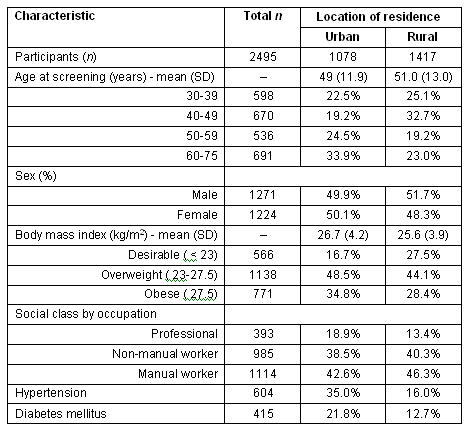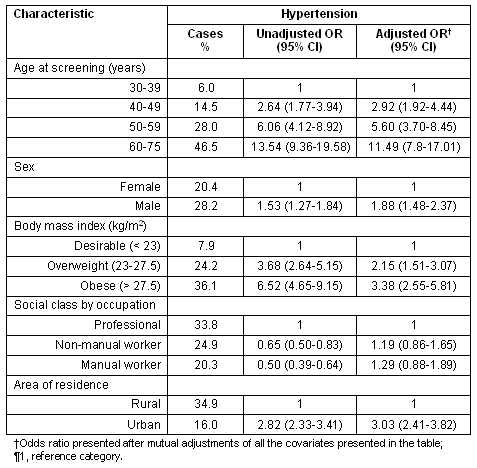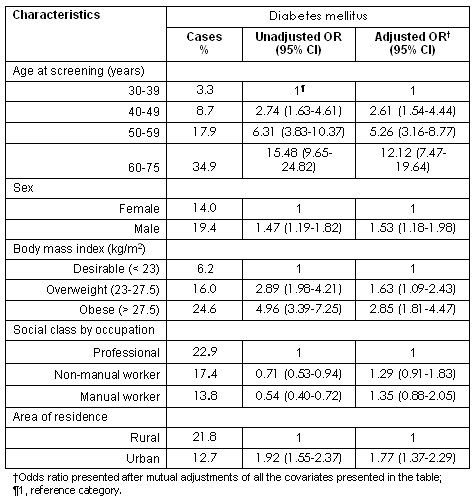The prevalence of cardiovascular disease and its risk factors are rapidly increasing world-wide. It has been found that one-quarter of the world's population is hypertensive, and modelled projections indicate that there will be 1.15 billion hypertensive patients in the developing world by 20251. The prevalence of cardiovascular disease and its adverse health effects are increasing more rapidly in the South Asian region than in any other world region2, and at a relatively younger age compared with other populations3-6. This is mainly attributed to an increased prevalence of known risk factors, such as hypertension, diabetes mellitus and obesity.
Pakistan, the world's sixth most populous nation (approximately 180 million population), is situated in this high risk region for cardiovascular disease, and the prevalence of those with cardiovascular risk factors is similar to that reported in neighbouring countries. Epidemiological surveys have reported a varied distribution of hypertension and diabetes mellitus according to the site of the study, age group of participants, and diagnostic criteria used7-9. The National Health Survey of Pakistan (1990-1994) reported hypertension prevalence to be 23% and 18% in urban and rural areas, respectively, and this is consistent with reports from neighbouring countries2,10,11. In a nationally representative sample, the prevalence of diabetes in urban versus rural areas was 6.0% in men and 3.5% in women as opposed to 6.9% in men and 2.5% in women, respectively12.
As in many low- and middle-income countries, urban (vs rural) populations in South Asia have a higher prevalence of certain chronic, non-communicable conditions, including hypertension, obesity and diabetes mellitus13-15. A substantial literature from developed and developing countries suggests that the distribution of cardiovascular risk factors is socioeconomically patterned16-18. Unfortunately little is known or has been published recently about the Pakistani population's distribution of hypertension and diabetes mellitus, according to the socioeconomic status and residence location.
Because risk modification is the foundation of cardiovascular disease prevention, it is essential to estimate these risk factors in population sub-groups to identify those at higher risk. The development and implementation of targeted preventive strategies can then proceed. This study investigated the distribution of hypertension and diabetes mellitus in relation to social class and location of residence in a Pakistani population, with the aim of exploring major determinants in urban and rural populations.
This study used the baseline data of a cohort Urban Rural Chronic Diseases Study (URCDS). This project was established mainly to investigate the risk factors of and their association with cardiovascular and other non-communicable chronic diseases among urban and rural populations. This population-based, cross-sectional study was conducted in the northeast of Punjab Province in Faisalabad city and included one peripheral rural area which is 35 km from the centre of the city. Faisalabad is the third largest city in the country with a population of approximately 6 million. The study area was selected as being typical of urban and rural populations in the Punjab Province.
The study protocol was assessed and approved by an independent ethics committee and the study was conducted in accordance with Declaration of Helsinki guidelines. The protocol was also approved by the hospital authorities involved. All the individuals provided written informed consent before their participation.
Study participants
Potential participants were approached by local religious and political leaders as key informants. As the local community gathers each week on Friday for prayers, information about the study was provided at this time, with a request for public participation. Participation was also invited at other public gatherings and forums.
Only apparently healthy individuals aged between 30 and 75 years were recruited. Participants visited the research project clinics in the out-patient departments of 3 hospitals (Afra General Hospital, Haider Medicare Hospital and New Lahore General Hospital) during the period 1 January 2006 to 31 June 2009. Participants included both males and females, those currently employed and retired individuals. Also invited to participate were those who accompanied a patient to a hospital visit for a routine health check (eg for blood pressure [BP] or blood glucose measurement, or for vision testing).
Data collection
Trained nurses interviewed consenting participants at all 3 hospitals, as well as taking anthropometric measurements and blood samples. Questionnaires were used to collect participants' demographic details, occupational and lifestyle information, medical history and the location of their residence for the past 5 years. After questionnaire completion, the nurses measured participants' height, weight, waist and hip circumferences and BP. At all the 3 study sites, participants' shoes were removed prior to height and weight measurement, and their BP was measured after a 5 min rest in a sitting position using a standard mercury sphygmomanometer.
A blood sample was obtained for fasting blood glucose level, total cholesterol, triglycerides and high density lipoproteins. C-reactive protein and microalbuminuria were also measured for a subset of the sample.
Participants were classified 'urban' or 'rural' according to their permanent residence in the past 5 years. Urban or rural location was defined according to the latest census information available from district councils, which define local areas as urban or rural according to parameters such as population size, transportation, communication, education and health facilities.
Social class was assigned to each participant on the basis of their occupation:
- upper class were professionals (those with executive jobs in the government or private sectors)
- middle class were non-manual workers (skilled individuals with office jobs)
- lower class were manual workers (unskilled workers or farmers).
Non-working women were assigned the social class of their husband or parents (if unmarried).
All collected data were stored in an MS Access database and a unique identifier was provided for each participant.
Statistical analysis
Stata software v11 (StataCorp; College Station, TX, USA) was used to analyze the collected data. Subjects were classified 'hypertensive' if hypertension had been diagnosed previously or if their BP was greater than 140/90 mmHg. Diabetes mellitus was defined as a fasting blood glucose level of less than 126 mg/dL or a self-report of previously diagnosed diabetes mellitus.
The prevalence of hypertension and diabetes mellitus was calculated and presented as percentages according to location of residence. Proportions were compared between groups with a Z-test, while means were compared using an independent sample t-test. Age was categorised in 10 year age groups. Body mass index (BMI; weight in kg/height m2) was categorised as normal, overweight or obese, using the recommended values for Asian populations (<23.5; 23.5-27.5; >27.5, respectively19).
A logistic regression model was used to explore the association between social class and location of residence. Initially, unadjusted odds ratio (OR) were calculated for each explanatory variable using the first category as reference, then the final model included all those explanatory variables which were significant on univariate analysis. No significant interactions between covariates were detected. In the final model, adjustments were made for age, sex, BMI, social class by occupation and location of residence.
Basic characteristics of the sample
Information was collected from 2700 individuals; however, due to missing information (BP, n=75; self-reported diabetes mellitus, and blood glucose level, n=47; height and weight, n=24; and social class, n=59), 2495 individuals were included in the final analysis. The mean age of subjects was 50.30 ± 12.49 with a range of 30-75 years. The number of males and females was approximately equal (50.9% and 49.1%, respectively).
Using the revised BMI categories for Asian populations, 46% of the participants were overweight while 31% were obese. Approximately half the sample (44%) was of lower social class (manual workers) while 40% were middle social class (non-manual workers). The overall prevalence of hypertension and diabetes was 24.2% and 16.6%, respectively (Table 1). Most cases of diabetes mellitus (n=339, 81.7%) and hypertension (n=409, 67.7%) were self-reported, and the screening only identified 76 and 195 new cases, respectively. Among these, slightly more new cases were in urban participants; however, this difference was not statistically significant.
Rural area residents comprised 56.8% of the total sample (n=1417), while 43.2% were urban (n=1078). In general, the urban population was slightly younger, more likely to be overweight and obese, more likely to be professional, diabetic and hypertensive. The characteristics of the urban and rural populations are described (Table 1).
Table 1: Baseline characteristics of sample, according to area of residence

Hypertension
Conventional and well-established risk factors associated with hypertension were also found to be significant in this population. The association of social class and location of residence was evaluated initially in a univariate model with following multivariate adjustments. On univariate analysis manual workers were 50% less likely to have hypertension compared with professionals (OR = 0.50, 95% CI 0.39-0.64). The association between location of residence and likelihood of hypertension was persistent (p<0.0001), even after multivariate adjustments for age, sex, BMI and social class (OR=3.03, 95% CI 2.41-3.82) (Table 2).
Table 2: Odds ratios for hypertension: univariate and multivariate analysis

Diabetes mellitus
Those of increased age, males, and overweight and obese individuals were significantly more likely to be have diabetes mellitus. Initially, lower social class predicted lower odds of diabetes mellitus, but this was not more significant after adjusting for age and sex. Furthermore, the association between the location of residence and likelihood of diabetes mellitus remained (p<0.0001), even after multivariate adjustments for age, sex, BMI and social class (OR=1.77, 95% CI 1.37-2.29) (Table 3).
Table 3: Odds ratios for diabetes mellitus: univariate and multivariate analysis

Discussion
This study found the prevalence of hypertension and diabetes to be 24.2% and 16.6%, respectively, which is relatively higher than previously reported from nationally representative samples12,20. Multiple explanations can account for this. The National Health Survey of Pakistan was conducted more than 15 years ago, making its findings relatively outdated. Additional explanations include increased awareness in the population, lifestyle transition in the last two decades, and an over-detection of cases. Any over-detection could be due to the age of participants (all >30years, and approximately half >50 years old) making them a high cardiovascular risk group. In relation to diabetes mellitus, although the national prevalence has been estimated recently12, the higher prevalence found by the present study may be due to differing prevalences among Pakistan's ethnic communities. For instance, as reported by the National Health Survey, the Baloch population had the highest prevalence of hypertension when compared with other ethnic communities20.
This study demonstrates that urban location of residence is independently and significantly associated with the odds of being hypertensive or having diabetes mellitus. Social class by occupation and location of residence had significant association with both hypertension and diabetes mellitus on univariate analysis. However, after multivariate adjustment, only location of residence had a significant relationship with hypertension and diabetes mellitus (Tables 2,3). This finding may be due to the occupation of individuals fluctuating over time, introducing the possibility of misclassification. Additionally, in Pakistan, social class by occupation does not essentially reflect an individual's wealth, which may influence an individual's health behaviour. In contrast, location of residence is less likely to change in the age groups selected for this study, and is, therefore, less prone to misclassification bias. Importantly, studies published in other South Asian countries have described similar trends for cardiovascular risk factors to be more prevalent in urban populations13-15.
Possible factors related to the increased odds of diabetes mellitus or hypertension in urban areas of residence include dietary transition (diet rich in fats, meats, more consumption of fast foods, low intake of vegetables and fruits), less physical activity, and environmental and job stressors. Another important determinant of rural-urban differences is the quality of and access to medical care. Both are better in urban areas and may have led to increased detection of the studied diseases among urban dwellers, and underestimation for those in rural areas.
The strengths of the study are its large sample size, the reasonably high number of cases, and that (to the authors' knowledge) it is the first study in Pakistan that has evaluated the combined association of social class and location of residence in relation to cardiovascular risk factors.
Limitations
The study has some potential limitations. First, the generalizability of results to other regions of Pakistan may be limited by the recruitment of some participants from hospitals, although they were healthy and selected using a convenience sampling method. In addition, because the general population was not randomly sampled, the study may not be representative of the urban or rural populations in the target region. Similarly, the subjects were of high risk due to their age; therefore, estimates may be higher for all age groups that what has previously been reported. Second, most of those with diabetes mellitus and hypertension were self-reported cases, although the difference in self-report between urban and rural locations was not statistically significant. The self-reporting of these conditions might have introduced information bias into study estimates, because those from urban areas may have had higher education, greater awareness of their own health and better access to healthcare facilities.
Despite its limitations, this study provides evidence that a targeted intervention and awareness campaign, particularly for those living in urban areas, may decrease the burden of cardiovascular diseases. Future research is needed to clarify how location of residence influences cardiovascular risk factors, and to explore which critical differences can be targeted to reduce risk.
This cross-sectional study demonstrated that location of residence (urban or rural) is a powerful and independent determinant of hypertension and diabetes mellitus in the Pakistani population. The urban population was more likely to demonstrate risk factors compared with rural dwellers, and this remained even after accounting for age, sex and BMI. Finally, the findings indicate that location of residence is a more important determinant of cardiovascular risk factors than social class (according to occupation).
Acknowledgements
The authors thank the nursing and paramedic staff who performed most of the data collection. They also extend their thanks to Muhammad Asif for his support in the collection and electronic compilation of this database. Their gratitude is also extended to Dr Muhammad Itfaque and Dr Rubina and James T Burns for their support and valuable suggestions in carrying out this research project. The authors are extremely thankful to the Health and Education Promotion Society for providing partial funding for this research (for the haematological and biochemical investigations).
References
1. Mittal BV, Singh AK. Hypertension in the developing world: challenges and opportunities. American Journal of Kidney Diseases 2010; 55(3): 590-598.
2. Ghaffar A, Reddy KS, Singhi M. Burden of non-communicable diseases in South Asia. BMJ 2004; 328(7443): 807-810.
3. Venkata C, Ram S. Hypertension and other cardiac risk factors among Asian Indians. American Journal of Hypertension 1995; 8(12:pt2): 124-127.
4. Lee J, Ma S, Heng D, Chew S, Hughes K, Tai E. Hypertension, concurrent cardiovascular risk factors and mortality: the Singapore Cardiovascular Cohort Study. Journal of Human Hypertension 2008; 22(7): 468-474.
5. Misra R, Patel T, Kotha P, Raji A, Ganda O, Banerji M et al. Prevalence of diabetes, metabolic syndrome, and cardiovascular risk factors in US Asian Indians: results from a national study. Journal of Diabetes and Its Complications 2010; 24(3): 145-153.
6. Tan CE, Emmanuel SC, Tan BY, Jacob E. Prevalence of diabetes and ethnic differences in cardiovascular risk factors. The 1992 Singapore National Health Survey. Diabetes Care 1999; 22(2): 241-247.
7. Hameed K, Kadir M, Gibson T, Sultana S, Fatima Z, Syed A. The frequency of known diabetes, hypertension and ischaemic heart disease in affluent and poor urban populations of Karachi, Pakistan. Diabetic Medicine 1995; 12(6): 500-503.
8. Safdar S, Omair A, Faisal U, Hasan H. Prevalence of hypertension in a low income settlement of Karachi, Pakistan. Journal of the Pakistan Medical Association 2004; 54(10): 506-509.
9. Shah SM, Luby S, Rahbar M, Khan AW, McCormick JB. Hypertension and its determinants among adults in high mountain villages of the Northern Areas of Pakistan. Journal of Human Hypertension 2001; 15(2): 107-112.
10. Sadeghi M, Roohafza HR, Kelishadi R. Blood pressure and associated cardiovascular risk factors in Iran: Isfahan Healthy Heart Programme. Medical Journal of Malaysia 2004; 59(4): 460-467.
11. Kaur P, Rao TV, Sankarasubbaiyan S, Narayanan AM, Ezhil R, Rao SR et al. Prevalence and distribution of cardiovascular risk factors in an urban industrial population in south India: a cross-sectional study. Journal of the Association of Physicians of India 2007; 55: 771-776.
12. Shera AS, Jawad F, Maqsood A. Prevalence of diabetes in Pakistan. Diabetes Research & Clinical Practice 2007; 76(2): 219-222.
13. Ramachandran A, Mary S, Yamuna A, Murugesan N, Snehalatha C. High prevalence of diabetes and cardiovascular risk factors associated with urbanization in India. Diabetes Care 2008; 31(5): 893-898.
14. Zaman MM, Yoshiike N, Rouf MA, Syeed MH, Khan MR, Haque S et al. Cardiovascular risk factors: distribution and prevalence in a rural population of Bangladesh. Journal of Cardiovascular Risk 2001; 8(2): 103-108.
15. Snehalatha C, Ramachandran A. Cardiovascular risk factors in the normoglycaemic Asian-Indian population--influence of urbanisation. Diabetologia 2009; 52(4): 596-599.
16. Conen D, Glynn RJ, Ridker PM, Buring JE, Albert MA. Socioeconomic status, blood pressure progression, and incident hypertension in a prospective cohort of female health professionals. European Heart Journal 2009; 30(11): 1378-1384.
17. Grotto I, Huerta M, Sharabi Y. Hypertension and socioeconomic status. Current Opinion in Cardiology 2008; 23(4): 335-339.
18. Gilberts EC, Arnold MJ, Grobbee DE. Hypertension and determinants of blood pressure with special reference to socioeconomic status in a rural south Indian community. Journal of Epidemiology and Community Health 1994; 48(3): 258-261.
19. World Health Organization, Western Pacific Region.The International Associationfor the Study of Obesity and the International Obesity Task Force. The Asia-Pacific perspective: redefining obesity and its treatment. Sydney, NSW: Health Communications Australia; 2000. Available: http://www.diabetes.com.au/pdf/obesity_report.pdf
20. Jafar TH, Levey AS, Jafary FH, White F, Gul A, Rahbar MH et al. Ethnic subgroup differences in hypertension in Pakistan. Journal of Hypertension 2003; 21(5): 905-912.
